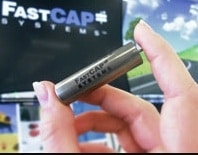source: prweb news
Boston, MA (PRWEB)September 22, 2016.
FastCAP’s Newest Technology Development Focuses on Ultracapacitors in Cube Satellites Under an SBIR Grant from NASA
FastCAP Systems continues to push the boundaries of ultracapacitor use in the aerospace sector as it develops technology under another SBIR Phase I award from NASA, this time focusing on cube satellites. FastCAP’s cutting edge ultracapacitor technology is well-suited for space missions, providing wide-temperature energy storage that is ruggedized and hermetically sealed. The award, entitled Ultracapacitor Based Power Supply for CubeSats, proposes an ultracapacitor based hybrid power supply (HPS) that will dramatically reduce the size and weight of conventional high power energy storage solutions while increasing power handling capability.
“Small satellites are extremely space limited with significant challenges in thermal management as power requirements increase to support a wider range of payloads. Our new capacitor modules are completely redesigned to meet the demanding requirements of small satellite platforms,” said Joseph Lane, FastCAP’s Director of Engineering and Principal Investigator for the NASA SBIR.
The intention of cube satellites is to provide a platform that private companies and academia can utilize for affordable space systems. Cube satellites enable the standardization, modularity, and industry required to make satellites affordable for an incredibly diverse group of engineers and scientists. They can be used as a test platform for college laboratories or as the work horse of major companies. Applications include world-wide internet, environmental protection, wild life preservation, planetary resource management including minerals and water, better weather predictions, city planning, population analytics, and more.
“FastCAP is happy to add value to a burgeoning market with its ruggedized and conformal ultracapacitor technology. We are encouraged by the trend in this market and are actively working to establish partnerships that will accelerate time to market for our ultracapacitor technology,” added John Cooley, President and CTO. FastCAP’s technology is positioned to have an impact across the board including launch vehicles with turbo-electric drives, linear actuators, and small satellites, to name a few.
FastCAP Systems’ line of high temperature, ruggedized, and hermetically sealed ultracapacitors surpass the performance metrics of any on the market today. The ultracapacitors are available for sale in two different form factors and three different temperature ranges up to 150°C.































